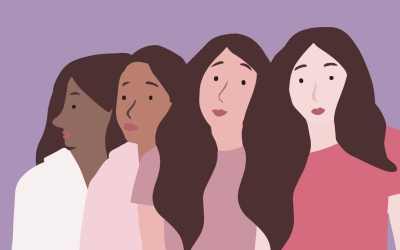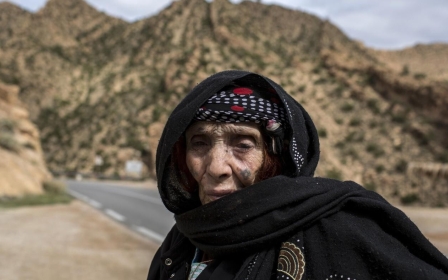BeYOUtiful: Helping girls feel confident in an airbrushed world

Scars, hair dye, melanin - they’re not the usual buzzwords around discussions of beauty, nor ones that would typically be found in books aimed at helping young girls feel more confident in a time of filters and airbrushed selfies. But that’s perhaps precisely why British author and advertising executive Shelina Janmohamed’s book BeYOUtiful has attracted considerable national media coverage in its first month of publication.
“I wanted to make a conversation about beauty not feel worthy, or onerous, which is also where I find a lot of conversations about self esteem and confidence, tend to fall,” the mother of two daughters, aged 11 and 7, tells Middle East Eye.
She adds that she would often run ideas past her girls through the course of writing the book. “They would be reading out certain sections, testing them out, thinking about key points that I wanted to make. What I found myself writing was something that tried to make serious points, but in a way that didn't take any of us too seriously.”
New MEE newsletter: Jerusalem Dispatch
Sign up to get the latest insights and analysis on Israel-Palestine, alongside Turkey Unpacked and other MEE newsletters
Amplifying women’s voices
The inspiration was her girls, Hana and Iman, Janmohamed says, and a comment the then five-year-old Hana made one day that caught her off guard.
“I remember I would look in the mirror and say things that a mother should never say in front of her daughter, which is ‘I’m not beautiful’… and I would critique the way I looked. She looked at me very seriously and said: 'Mummy, you're beautiful, you shouldn’t say that.'"
“That feeling of pride, that I have brought this girl up well to adhere to her feminist principles and tell me off, was mixed with worry about what was going to happen as she grew up and became much more exposed to ideas about what a woman should look like and what her place should be."
It's time to start a girl-powered revolution! I've written this from the heart, to be the book we all wished we had as girls, exploring what it means to be beautiful and giving girls the tools to decide FOR THEMSELVES.
— Shelina Janmohamed (@loveinheadscarf) May 12, 2022
Out today!#HowToBeYOUtiful https://t.co/XE2356UF6E pic.twitter.com/OZCjg4LiCR
Amplifying and giving voice to women’s experiences has been a consistent theme reflected in Janmohammed’s writing, from Love in a Headscarf - a personal memoir published in 2009 - to a young adult biography of Wimbledon champion Serena Williams in 2020.
With BeYOUtiful, Janmohamed says she spent much time thinking about how women are perceived, and how to articulate what it meant to be a woman. “What visually should a woman look like? Who decides? And how can women assert themselves? That’s the lens I was coming at it from… and having found myself in advertising, which has such a powerful role in shaping our ideas of culture, particularly womanhood, it just struck me that beauty isn't a trivial or superficial thing.”
“What I concluded was that beauty and the study of beauty is itself a worthy pursuit,” she adds. “I wanted girls to see that it's not singular. There's no fixed idea. And by extension, therefore, there is no singular fixed idea of what it means to be a woman.”
‘Skintastic’
In one section titled Skintastic, which highlights celebrities with "unique spots of beauty" - such as Meghan Markle’s (often airbrushed) freckles and Canadian-Jamaican model Winnie Harlow, who has vitiligo (a condition that causes patches of pigmentation loss in the skin) - Janmohamed also discusses how scars are a form of repair from traumatic events, and erroneously seen as a flaw.
“When skin is damaged such as by cuts and burns, it has the amazing ability to repair itself. Emergency skin looks different and we call it a scar,” she explains in the book. “Weirdly, too many stories and films associate scars with villains. When in fact, a scar is actually yet another sign of your superhero skin. All of these are part of the unique story your skin tells about you. And loving them is an important part of loving yourself.”
“It’s about trying to flip our ideas and get underneath why our bodies are so amazing, and the stories our bodies tell about who we are,” she says.
Carefully curated images
That message of positivity starkly contrasts with the world young users engage with and often feel immense pressure from on social media, where finished looks are often the result of a combination of lighting, editing, and filters. From "Instagram Face" to "Snapchat Dysmorphia" - an obsession with using filters to get rid of the perceived flaws in one's face or body - Janmohamed felt it was critical to explain how images are created and curated behind the scenes.
“I wanted to show how many people it takes to create that image and how the models are selected. It's not just one model who is the epitome of beauty. Lots of people are involved in selecting who she is and styling her and putting her make-up on, and using all sorts of props.
"Hundreds of photos will be taken and from that, narrowed down to one model. In the end, one photo is selected and that's the photo that might well be touched up. So it's not really a representation of what that person looks like in real life.”
Overall screen use among teens (ages 13-18) and tweens (ages 8 to 12) increased by 17 per cent during the COVID-19 pandemic — growing more rapidly than in the four years prior, according to a survey published last month by Common Sense Media, a U.S. nonprofit research organization. More worrying however, is the upswing in social media use among children ages 8 to 12 on platforms such as Instagram, Snapchat and Facebook, despite such platforms requiring users to be at least 13.
“Our expectation might be that social media is a real reflection of a woman or a girl,” Janmohamed adds. “But even on social media, despite the fact it started as people showing their real lives, there may well be many things that you can't see.”
Middle East Eye delivers independent and unrivalled coverage and analysis of the Middle East, North Africa and beyond. To learn more about republishing this content and the associated fees, please fill out this form. More about MEE can be found here.





